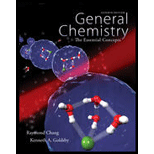
Concept explainers
(a)
Interpretation:
The
Concept Introduction:
Ionic bond is the electrostatic force of attraction that binds ions of opposite charges into a stable molecule. Electronegativity difference between the atoms must be greater than
Covalent bond refers to the bond formed between two atoms by mutual sharing of electrons – that each atom shares equal number of electrons between them and the charge distribution (electron) between the two atoms held by covalent bond is symmetrical. The difference in electronegativity between these two atoms is very less or the two atoms have same electronegativity. Electronegativity difference between the atoms must be nil or highly lower than
Polar covalent bond refers to the covalent bond which has polarity caused by unsymmetrical distribution of bonding electrons between the two atoms. When atoms of moderately different electronegativity bonded by mutual sharing of electrons, the atom having more electronegativity tend to pull the electron cloud towards it. This leads to unsymmetrical distribution of electrons between the bonded atoms that one end of the molecule develops slight positive charge and another end of the molecule develops slight negative charge. This is called polarity and such bond is called polar covalent bond.
Electronegativity difference between the atoms must be
(b)
Interpretation:
The
Concept Introduction:
Ionic bond is the electrostatic force of attraction that binds ions of opposite charges into a stable molecule. Electronegativity difference between the atoms must be greater than
Covalent bond refers to the bond formed between two atoms by mutual sharing of electrons – that each atom shares equal number of electrons between them and the charge distribution (electron) between the two atoms held by covalent bond is symmetrical. The difference in electronegativity between these two atoms is very less or the two atoms have same electronegativity. Electronegativity difference between the atoms must be nil or highly lower than
Polar covalent bond refers to the covalent bond which has polarity caused by unsymmetrical distribution of bonding electrons between the two atoms. When atoms of moderately different electronegativity bonded by mutual sharing of electrons, the atom having more electronegativity tend to pull the electron cloud towards it. This leads to unsymmetrical distribution of electrons between the bonded atoms that one end of the molecule develops slight positive charge and another end of the molecule develops slight negative charge. This is called polarity and such bond is called polar covalent bond.
Electronegativity difference between the atoms must be
(c)
Interpretation:
The
Concept Introduction:
Ionic bond is the electrostatic force of attraction that binds ions of opposite charges into a stable molecule. Electronegativity difference between the atoms must be greater than
Covalent bond refers to the bond formed between two atoms by mutual sharing of electrons – that each atom shares equal number of electrons between them and the charge distribution (electron) between the two atoms held by covalent bond is symmetrical. The difference in electronegativity between these two atoms is very less or the two atoms have same electronegativity. Electronegativity difference between the atoms must be nil or highly lower than
Polar covalent bond refers to the covalent bond which has polarity caused by unsymmetrical distribution of bonding electrons between the two atoms. When atoms of moderately different electronegativity bonded by mutual sharing of electrons, the atom having more electronegativity tend to pull the electron cloud towards it. This leads to unsymmetrical distribution of electrons between the bonded atoms that one end of the molecule develops slight positive charge and another end of the molecule develops slight negative charge. This is called polarity and such bond is called polar covalent bond.
Electronegativity difference between the atoms must be
(d)
Interpretation:
The
Concept Introduction:
Ionic bond is the electrostatic force of attraction that binds ions of opposite charges into a stable molecule. Electronegativity difference between the atoms must be greater than
Covalent bond refers to the bond formed between two atoms by mutual sharing of electrons – that each atom shares equal number of electrons between them and the charge distribution (electron) between the two atoms held by covalent bond is symmetrical. The difference in electronegativity between these two atoms is very less or the two atoms have same electronegativity. Electronegativity difference between the atoms must be nil or highly lower than
Polar covalent bond refers to the covalent bond which has polarity caused by unsymmetrical distribution of bonding electrons between the two atoms. When atoms of moderately different electronegativity bonded by mutual sharing of electrons, the atom having more electronegativity tend to pull the electron cloud towards it. This leads to unsymmetrical distribution of electrons between the bonded atoms that one end of the molecule develops slight positive charge and another end of the molecule develops slight negative charge. This is called polarity and such bond is called polar covalent bond.
Electronegativity difference between the atoms must be
Want to see the full answer?
Check out a sample textbook solution
Chapter 9 Solutions
General Chemistry
 ChemistryChemistryISBN:9781305957404Author:Steven S. Zumdahl, Susan A. Zumdahl, Donald J. DeCostePublisher:Cengage Learning
ChemistryChemistryISBN:9781305957404Author:Steven S. Zumdahl, Susan A. Zumdahl, Donald J. DeCostePublisher:Cengage Learning ChemistryChemistryISBN:9781259911156Author:Raymond Chang Dr., Jason Overby ProfessorPublisher:McGraw-Hill Education
ChemistryChemistryISBN:9781259911156Author:Raymond Chang Dr., Jason Overby ProfessorPublisher:McGraw-Hill Education Principles of Instrumental AnalysisChemistryISBN:9781305577213Author:Douglas A. Skoog, F. James Holler, Stanley R. CrouchPublisher:Cengage Learning
Principles of Instrumental AnalysisChemistryISBN:9781305577213Author:Douglas A. Skoog, F. James Holler, Stanley R. CrouchPublisher:Cengage Learning Organic ChemistryChemistryISBN:9780078021558Author:Janice Gorzynski Smith Dr.Publisher:McGraw-Hill Education
Organic ChemistryChemistryISBN:9780078021558Author:Janice Gorzynski Smith Dr.Publisher:McGraw-Hill Education Chemistry: Principles and ReactionsChemistryISBN:9781305079373Author:William L. Masterton, Cecile N. HurleyPublisher:Cengage Learning
Chemistry: Principles and ReactionsChemistryISBN:9781305079373Author:William L. Masterton, Cecile N. HurleyPublisher:Cengage Learning Elementary Principles of Chemical Processes, Bind...ChemistryISBN:9781118431221Author:Richard M. Felder, Ronald W. Rousseau, Lisa G. BullardPublisher:WILEY
Elementary Principles of Chemical Processes, Bind...ChemistryISBN:9781118431221Author:Richard M. Felder, Ronald W. Rousseau, Lisa G. BullardPublisher:WILEY





